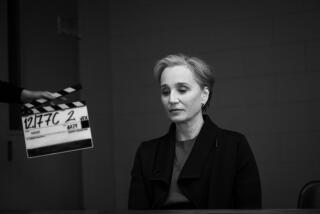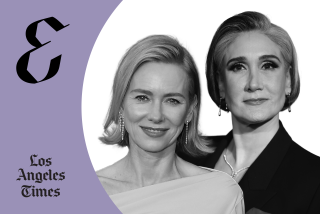The Strength of ‘Girls’ Is Skin Deep
In Jack Mathews’ review of “Kiss the Girls,” he writes: “[Gary] Fleder has directed three-quarters of a terrific movie and one-quarter of pure Hollywood baloney,” letting the film “trail off in anti-climax and banal violence” (“Trailing Another Serial Killer in ‘Kiss,’ ” Calendar, Oct. 3).
What Mathews doesn’t mention in his review is how much this film suffers from its own subversion of one of the main characters: Kate McTiernan (played by Ashley Judd).
Fleder says he was drawn to the original James Patterson story because of its “strong female character,” but the director’s portrayal of Kate in this film ultimately leaves her as yet another weak and passive feminine creature who, when push comes to shove, is incapable of standing up to and saving herself from the boogeyman.
Set up from the beginning of the film as not only physically strong (we’re supposed to believe this because she takes kick-boxing lessons) but also intelligent (she’s a doctor), Kate is yet another example of contemporary Hollywood’s misrepresentation of “strong women,” a weak attempt to satisfy those of us who yearn for better and more diverse cinematic portrayals of women.
Yes, Kate starts off the movie strong, smart and powerful, but after her brave escape from the serial killer who holds her, and a harem of other women, captive, Kate’s “strong female character” is slowly but surely extinguished as the film consistently places her in a position subordinate to the men with whom she interacts.
Come on! Are we supposed to believe that a woman who fights and scrapes her way to freedom early in the film will sit cowering in a corner when attacked by the same man later on, whimperingly awaiting her savior who, in Hollywoodland, must come not riding in on a white horse, but brandishing a big gun?
To place Kate in this position at the end of the story is to subvert the film’s own logic and disrespect the audience’s intelligence . . . and, of course, to sneakily reproduce traditional gender roles for those uncomfortable with truly powerful women.
But that’s not the only issue I have with the portrayal of women in “Kiss the Girls.” What about the other “extraordinary” women in this film, those the serial killer keeps locked in his lair? We are told early on that these women are not “typical” serial killer victims: sure they are young and beautiful, but they are also “exceptional” in some way.
*
Really? Yes, we see some of this extraordinariness in Kate (after all, she’s a kick-boxing surgeon who wields a chef’s knife with extreme dexterity, especially when chopping carrots), and we hear this exceptionality in one of the captive women’s violin playing.
But that’s as far as Fleder will take us in showing how “extraordinary” these women are, for he never allows the other captives to demonstrate their talent, intellect or physical resilience. Instead, he relies on typical Hollywood codes for communicating the extraordinary: physical beauty.
Give me a break. If this is what ‘90s male filmmakers think of as “exceptional women,” maybe they should do a little homework. Though young male directors like Fleder obviously think having “strong female characters” like Kate is some giant step forward for womankind, such an idea far precedes our current generation.
Thanks anyway, Gary, but I’ll take Katharine Hepburn, Marlene Dietrich or Barbara Stanwyck over any of today’s steel-bunned beauties.
Kick-boxing does not a strong woman make.
Mary Celeste Kearney is a doctorate candidate at USC’s School of Cinema-Television. She is currently writing her dissertation on the representation of female adolescents in contemporary U.S. media.
More to Read
Only good movies
Get the Indie Focus newsletter, Mark Olsen's weekly guide to the world of cinema.
You may occasionally receive promotional content from the Los Angeles Times.







